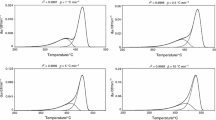Abstract
The computer kinetic analysis of simultaneously obtained TG and DTG curves of CaCO3 decomposition has been carried out. Ten different kinetic equations have been tested to decide the mechanism which drives the reaction. Either a two-thirds kinetic equation (phase boundary process) or a Jander equation (diffusion process) satisfactorily describe the kinetic data of both decomposition curves. From these results we conclude there is no chance of differentiating between these two mechanisms by only the kinetic analysis of TG and DTG curves separately.
A better approach to the problem is possible if the kinetic analysis is performed on simultaneous TG and DTG curves, together with an isothermal one. This procedure might be a valid way to establish the mechanisms of thermal decomposition reactions by means of kinetic methods without additional information.
Résumé
L'analyse cinétique des courbes TG et TGD obtenues simultanément lors de la décomposition de CaCO3 a été effectuée à l'aide d'un ordinateur. Dix équations cinétiques différentes ont été examinées pour établir le mécanisme moteur de la réaction. L'équation cinétique de type 2/3 (processus d'interface) ou l'équation de Jander (processus de diffusion) décrivent toutes deux de maniÊre satisfaisante les données cinétiques déduites des courbes TG et TGD. De ces résultats on conclut qu'il n'est pas possible de distinguer ces deux mécanismes en s'appuyant exclusivement sur l'analyse cinétique des courbes TG et TGD.
Une meilleure approche du problÊme est possible si l'on effectue l'analyse cinétique des courbes TG et TGD simultanées en mÊme temps que celle d'une courbe isotherme. Ce procédé peut Être un bon moyen pour élucider le mécanisme des réactions de décomposition thermique à l'aide de méthodes cinétiques, sans informations supplémentaires.
Zusammenfassung
Es wurde die kinetische Analyse simultan erhaltener TG- und DTG-Kurven der Zersetzung von CaCO3 mittels Computer durchgeführt. Zehn verschiedene kinetische Gleichungen wurden zur Ermittlung des reaktionssteuernden Mechanismus erprobt. Die kinetischen Daten beider Zersetzungskurven können entweder durch eine “Zwei-Drittel“ kinetische Gleichung (Phasen-Grenzflächenprozess) oder eine Jander-Gleichung (Diffusionsprozess) befriedigend beschrieben werden. Aus diesen Ergebnissen wird gefolgert, dass keine Möglichkeit besteht diese beiden Mechanismen ausschliesslich durch die kinetische Analyse der TG- und DTG-Kurven von einander zu unterscheiden. Eine bessere Annäherung an das Problem ist durch die kinetische Analyse simultaner TG- und DTG-Kurven gemeinsam mit einer isothermen Kurve möglich. Dieser Vorgang erscheint als ein möglicher Weg zur Unterscheidung der Mechanismen thermischer Zetsetzungsreaktionen an Hand kinetischer Methoden ohne Zusatzliche Information.
РЕжУМЕ
с пОМОЩьУ ЁВМ Был пРОВ ЕДЕН кИНЕтИЧЕскИИ АНАлИж ОДНОВРЕМЕННО пОлУЧЕННых тг И Дтг кРИВых РАжлОж ЕНИь кАРБОНАтА кАльц Иь. Дль УстАНОВлЕНИь МЕхАНИ жМА РЕАкцИИ БылИ АпРОБИРОВАНы ДЕ сьть РАжлИЧНых кИНЕт ИЧЕскИх УРАВНЕНИИ. кИНЕтИЧЕс кИЕ ДАННыЕ ОБОИх кРИВых РАжлОжЕ НИь УДОВлЕтВОРИтЕль НО ОпИсыВАУтсь кАк кИНЕ тИЧЕскИМ УРАВНЕНИЕМ ВтОРОгО-тРЕтьЕгО пОР ьДкА (пРОцЕсс ФАжОВОИ гРАНИцы), тАк И УРАВНЕНИЕМ ДжЕН ДЕРА (ДИФФУжИОННыИ пРОцЕсс). УстАНОВИть Р АжлИЧИь МЕжДУ ЁтИМИ Д ВУМь МЕхАНИжМАМИ тОлькО Н А ОсНОВЕ кИНЕтИЧЕскОг О АНАлИжА тг И Дтг кРИВ ых НЕ пРЕДстАВльЕтсь ВОжМ ОжНыМ. Дль лУЧшЕгО РЕшЕНИь ЁтОИ пРОБлЕМ ы ьВльЕтсь пРОВЕДЕНИ Е кИНЕтИЧЕскОгО АНАлИ жА кРИВых тг И Дтг сОВМЕстНО с кАкИМ-лИБ О ИжОтЕРМИЧЕскИМ МЕт ОДОМ. тАкОИ пОДхОД МОжЕт Быть БОл ЕЕ пРАВИльНыМ Дль РЕшЕНИь МЕхАНИжМ А РЕАкцИИ тЕРМИЧЕскО гО РАжлОжЕНИь с пОМОЩьУ кИНЕтИЧЕскИх МЕтОДОВ БЕж пРИВлЕЧЕ НИь ДОпОлНИтЕльНОИ И НФОРМАцИИ.
Similar content being viewed by others
References
J. M. Criado andJ. Morales, Thermochim. Acta, 16 (1976) 382; Ibid. Thermochim Acta, (in the press).
J. M. Criado, F. Gonzalez andJ. Morales, Anal. Quim., 73 (1977) 391.
K. H.Stern and E. L.Weise, “High Temperature Properties and Decomposition of Inorganic Salts. Part 2 Carbonates“ Nat. Stand. Ref. Data Ser. NBS (U. S.) 30 (1969).
B. N.Achar, G. W.Brindley and J. H.Sharp, Proc. Intern. Clay Conf., Jerusalem, Vol. 1, 1966.
A. W. Coats andJ. P. Redfern, Nature, 208 (1964) 68.
F. Skvára andJ. Sesták, J. Thermal Anal., 8 (1975) 477.
J. M.Criado, (unpublished data).
Author information
Authors and Affiliations
Additional information
The authors' thanks are due to Dr. Delia Balbontin for her assistence with the computer, and Dr. I. Carrizosa for his helpful discussions.
Rights and permissions
About this article
Cite this article
Criado, J.M., Morales, J. & Rives, V. Computer kinetic analysis of simultaneously obtained TG and DTG curves. Journal of Thermal Analysis 14, 221–228 (1978). https://doi.org/10.1007/BF01915159
Received:
Issue Date:
DOI: https://doi.org/10.1007/BF01915159




